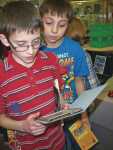Technology helps West Elementary meet AYP standards

For years, West Elementary had been the school always failing the state's Annual Yearly Progress standards.
It was the school parents tried to avoid sending their children to if they could.
Not anymore.
Hard work by teachers, administrators and parents working together, as well as some new teaching techniques and technology, have transformed the school into one of the state's best -- an achievement recognized recently by being named a four-star school.
During the first eight years of the state's AYP testing program, roughly one third of West's students typically failed the reading portion of the state's ISAT performance tests and just under one half were considered proficient in reading -- that is, reading at or above their grade level.
Today, more than 87 percent of the school's students are considered proficient at reading.
In 2010, Sherri Ybarra, who is now the district's new curricilum director, took over at principal at West.
She faced a major problem. A high population of the students in the school were from "economically disadvantaged" homes, or they didn't speak English, either at all or well.
Combined, they represented 80-90 percent of the school's population, and those two factors, being poor and being unable to speak English well, are considered key factors in students performing poorly in schools.
Many students, for example, couldn't have found a single book in their homes.
The odds were stacked against teachers trying to teach reading.
"You either read or you don't," Ybarra said. "We have a saying as teachers, in kindergarten through third grade, you learn to read. From about fourth grade on, you read to learn."
Reading is fundamental to success in school and life, she noted.
And since the traditional methods of teaching reading weren't working, she went looking for alternatives and found the myOn program, an online reading curriculum that supports the efforts of the classroom instructor by "personalizing" reading for each student. The software tracks their progress, helps the teachers identify areas where the students need extra help, and then moves them on to the next level when they're ready.
It "provides access to the largest collection of over 4,000 enhanced digital books with reading supports and embedded measurement capabilities. And that's when the magic began," Ybarra said.
To make that magic work, however, the school needed some technology so students could access the program.
So, they wrote some grants for some new iPads and notebooks, gratefully accepted any donations of such devices from parents, and worked with the PTT (parent-teacher support group) to raise funds to buy even more devices, including cell phones that also can utilize the onMy program, and to provide wi-fi capability throughout the school.
"The parents were very supportive. Once we got the message out about what we were trying to do and what we needed, they stepped up to help. I could not have had a more supportive group of parents as I had at West," Ybarra said.
The goal was to try and provide at least a full "classroom set" of mobile devices.
In the meantime, the teachers were attending specialized training sessions to teach them how to fully exploit the new technology in their classrooms.
"You can't just say, here's an e-book. Read it. This was an extra tool for the teachers to use when they were teaching reading, and they learned how to use it," Ybarra said.
The technology and the myOn reading program quickly became a great motivator for the students.
"The kids love it. And if they like something, they will do it. With reading, you need to practice it a lot if you want to get good at it.
"We wanted the students to take control of their reading, and with myOn, they did."
Ybarra said the students enjoyed it so much many complained about having to go to recess when they wanted to be reading instead.
The myOn program also features a number of options. It can, for example, read a story to the student "so they can hear what a good reader sounds like," Ybarra said.
It also links to the Accelerated Reading program the district uses. Sometimes a student is reading an e-book, sometimes they're reading a hard-copy book. "It doesn't matter what the medium is," Ybarra said, "we just wanted our kids to read. This was just another resource to get them to do that. But the students were the deciding factor, and they love it.
"When I saw the reports on how many books the kids had read over the course of a year, I couldn't have been happier." Last year, for example, West students read over 18,500 books in just one school year. "That was huge. They were motivated."
Earning four-star status was "quite the achievement," Ybarra said, but the school isn't resting on its laurels. There's a rare five-star status out there and a blue-ribbon school designation they're shooting for as well.
West, as it turned out, was the pilot program for the district. With Ybarra moving up to the district office as director of curriculum, she's moving the myOn reading program into all the other district elementary schools.
"In some schools, right now, it's 'bring your own device,' but people are donating their old cellphones and notebooks to the schools so we can build those classroom sets we need.
"If someone wants to donate something, contact the child's school and they can give you directions for clearing the machines so we can use them."
Ybarra said the success at West, which she hopes to spread throughout the district, is a product of using every tool available to not only teach students how to read, but to get them to want to read.
"Use a Kindle or iPad, use myOn, use a library. It doesn't make any difference what the medium is. Just read," she said.
